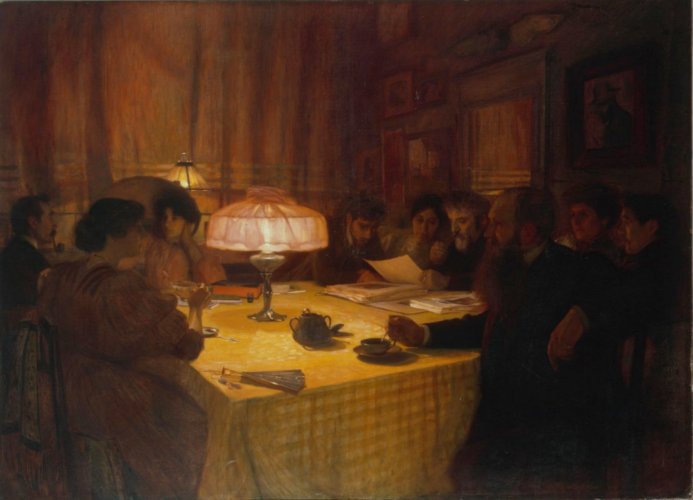Henri-Jules-Ferdinand Bellery-Desfontaines (1867-1910), known as Henri Bellery–Desfontaines was a French painter, a representative of Art Nouveau. He was mainly engaged in applied art, lithography, and made illustrations for books, magazines and vignettes due to financial reasons. He was interested in posters. He designed banknotes and fonts. He studied at the Académie Julian in Paris with Pierre–Victor Gallard, William Bouguereau and Jean–Paul Laurens. He collaborated in the execution of paintings for the Paris City Hall and the Pantheon. He was a member of the Société Nationale des Beaux–Arts. He was part of this group of young people who, over time, moved away from painting towards decorative art and its vision of a total, holistic creation of the world. It is hard to imagine a more suitable place than the vibrant Paris around 1900*.
In his works, H.-J.-F. Bellery–Desfontaines mainly depicted genre and allegorical scenes. The painting “Among Friends” presented in the Rogaliński Gallery is one of the few group portraits created by the artist. The viewer’s attention is focused on the figures gathered around the table. Engrossed in their affairs, they look through the graphics, illustrations and brochures lying on the table. They do not notice either the artist looking at them attentively or the viewer admiring their creations. The scene seems to be an authentic, unposed, instantly captured, almost documentary photograph.
Description of the painting:
The painter invites us to a closed interior. It is evening. The curtained windows give the room a more intimate character. Nine people, four women and five men, are sitting around a square table in the right corner of the room. As the title of the painting suggests, these are not random figures. This is a group of friends. They spend time together discussing. They look at illustrations, perhaps lithographs stored in a tied cardboard folder and those decorating the lying books and brochures.
The composition of the representation with the left free space at the table opens to the viewer, one can even think that it invites us to join the ongoing discussions. However, none of the painted figures looks towards us. It remains to the viewer only the role of observer. This carefully thought out and determined by the artist scene reminds of the photographs appearing in magazines presenting members of literary societies, discussion clubs, the intellectual elite of the city. Observed in the heat of the debate and captured there.
The painting is recognized as one of the artist’s most interesting works. Attention is focused on the light. It unifies the painted figures, it becomes the central point of the representation. The light on the Henri Bellery-Desfontaines painting is slightly muted, desired, subordinated and tamed. Additionally duplicated by the second oil lamp placed closer to the window. The figures sitting to the right and left of the lamp are immersed in half-darkness. The viewer’s attention is focused on the sources of brightness and on the objects lying on the table. Those that make the time spent in the company of friends enjoyable, the dishes from which the participants of the dispute sip their favorite drinks, but also those undoubtedly the subject of talks and discussions: lithographs, books, illustrations.


